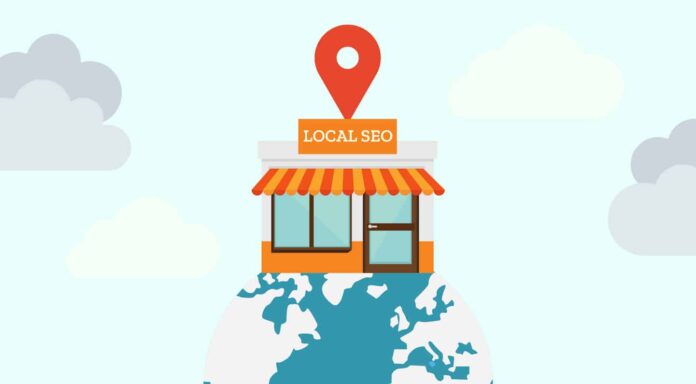Targeting to compete with big brands in your niche when you are just starting out is simply a foolish strategy. The online business world isn’t the place where the David and Goliath concept works. When you are a small business owner or a startup business, you need to start on your level and after you succeed in ranking in your bracket, that’s the time to aim to step up to the next level.
It isn’t always wise to do aggressive SEO. Take time to learn the process and gain profit from each level.
This is why starting with your Local SEO is important, most especially when your business provides tangible products that you offer in your vicinity only like a restaurant or an automotive repair shop. These kinds of businesses should focus on gaining popularity in their local area first and target a wider reach when your business grows or when you branch out or aim to go international.
While national SEO focuses more on ranking in searches across the country, local SEO prioritizes appearing on SERPs in a specific location which is what most users always use when they are looking for services or products within their area.
People looking for restaurants would search on Google “best Mexican food nearby” or “best pizza in Stockton, California.”
Hence, aiming to rank for local keywords will help you rank number 1 for those searches. Besides, it is easier to rank when you start locally where there is less competition.
Make a buzz and when achieve enough popularity, then that’s the time you go national.
Strategies for Boosting Your Local SEO
Optimizing your local SEO means more conversions, traffic, and leads. This focused strategy will help you compete more effectively against larger national brands that have a bounty of resources for paid campaigns.
Furthermore, you should take advantage of the fact that 35% of all your search traffic is local. Without local SEO, your business could be losing out on a significant amount of traffic. To help you out, I listed some of the things you can do for your local SEO boost:
Before you do any SEO strategies, be sure to create your Google My Business account and claim your business. This lets Google know that your business exists FOR FREE and you can soon see your business on the right section of the SERP when you search your business or any of your ranking keywords.
This will also put you on Google Maps so that when anyone searches for the services you offer, they will be given directions to where they can find you. Furthermore, Google authenticates your business as legitimate if you are on Google My Business.
The task doesn’t stop with creating your account. You need to optimize your Google My Business too.
- Verify your product or service listing.
- Place accurate and up-to-date information in your account.
- Decide on a logo and upload it on your account. Include your hours of operation, products and services, acceptable payment methods, and images related to your business like front of your office photos, inside the office, and more importantly, your products.
- Encourage your previous customers to leave a review on Google.
- Respond to customer reviews.
- Create content within your account.
People don’t want to waste their time going from one store to the other just so to find the right place to buy from products or services from. To avoid this kind of hassle, people now search for reviews. So make sure that you get some from your previous customers to help other netizens get an idea on the quality of your offerings.
Furthermore, reviews will help optimize your Google My Business presence. The more you get, the more chances of ranking.
Now, when asking your customers to leave a review, here are some things you should keep in mind:
- Ask for a review after you close a sale in person.
- Ask for their email so you can send them a message requesting to leave a review on Google.
- Respond professionally to reviews. If there any negative comments then manage the damage it may cost by telling the customer that you are sorry for their not so favorable experience and make sure to mention that you appreciate their opinion as they will serve as guide for your business improvement.
I mentioned in a couple of my previous blogs that optimizing for voice search is the trend this 2020. Mobile phones are becoming smarter, now equipped with AI that allows for hands-free search. It is then vital that your local SEO be optimized for voice search.
Make your keywords more natural like “where to eat the best Korean cuisines here in Sydney Australia” rather than focusing on the traditional style of typing a keyword like “best Korean cuisines Sydney Australia“. Make your local SEO stints feel like you are talking with your customers in person.
Include news and events in your featured stories on your blog section. This will help people know that you are involved in local issues and happenings.
Additionally, share stories composed by others that feature your business. This will help others know the quality of your products and services and how loved you are by the locals.
You can also create videos about local charity activities you were involved in or even those that you are not included for as long as you support the group. Consider setting up location-specific webpages too on your website with high-quality local content if you serve different parts of a region.
For instance, if you are a travel agency and you have packages for different cities, then create pages for each to make it easier for researchers to browse through your site for what they need.
Most of the internet researchers do their search on the products and services they need on their phones. With the convenience that smartphones bring, the shift to mobile is occurring faster than expected. In fact, more than 50% of searches done on the web are from mobile phones and the growth started in 2017 when voice assistants on mobiles were improved.
In another study by Acquisio in 2017, it was measured that 75% of all the mobile searches have local intent producing in-store, offline visits within 24 hours.
So if you optimize your local website, be sure to include SEO for mobile. To do that, here are some of my tips.
- Make your user interface intuitive for greater user experience
- Make sure you site loads quickly on mobile
- Use bigger fonts that are easy to read
- Use images and copy sparingly, conveying only the information you need (people hate browsing through long pages on their phones)
Like I already mentioned, your keywords should be relevant to local customers so include geo locations in your keyword planning. This should be easy since Google has its own Keyword Planner that lets you filter keyword searches based on location. This will give you an idea on which search terms are popular for a given region. This lets you create a list of locally relevant keywords to target. After identifying them, you should use them on your website, making sure they appear on like the page URL, meta content, and copy.
Also, include mentions of region-specific landmarks and hotspots in your content. For instance, if your local restaurant serves dinner in downtown Seattle, include references to “dining by the Space Needle” or “just steps from the Space Needle” on your site.
This is highly relevant if your business has multiple locations. You should provide the following for each page:
- Name of branch, address and phone number
- Store hours of each branch
- Individualized descriptions
- Promotions
- Testimonials
- Google Maps attached to each location page
- Other important details useful to customers like Parking availability
There are online business directories like Yelp, Foursquare, and YellowPages that a lot of customers use to find businesses related to what they need. They refer to these websites to find business names, addresses, and phone numbers. Being in these websites will help you boost your local SEO so don’t miss out on the opportunity and list your business with them.
Your listing on these websites should include the following:
- Accurate details about your business like name, address, logo and phone numbers. They should also be consistent across all directories
- A backlink to your website
- A thorough description of your business
Don’t just lump all of your products or services together in one page. This will confuse your customers. Instead, create one page dedicated to each unique product or service you offer just like how I suggested you to create one page per branch location of your business.
Final Thoughts on Local SEO
SEO trends change rapidly as the search engines update their algorithm every day. Whatever algo comes out, though, it is always a must to work on your local SEO. By implementing these 10 actionable items, your local SEO will be improved in no time.
Take advantage of lucrative local searches and grow your business from local to national to international.


